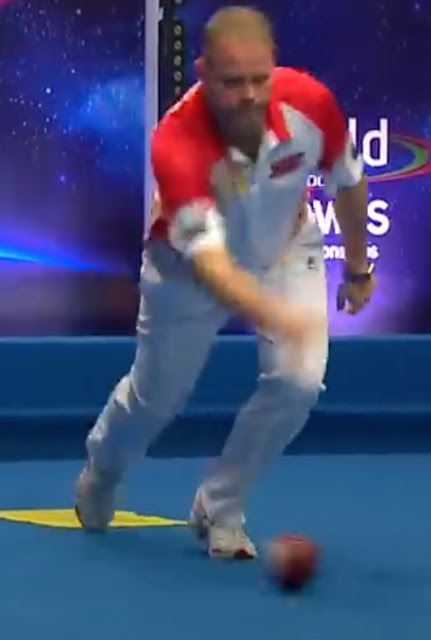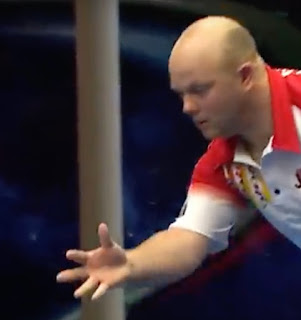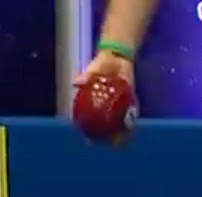I bowl from the Shooters’ stance. My anchor foot is positioned at an angle of 45 degrees to the line of delivery. I have chosen this because it provides less side-to-side tilting during my stepping when I am on one foot only. For the set-up, I use the South African foot positioning which places the stepping foot one-half a stride in front of the anchor foot. This reduces the length of the forward stride and reduces the time that I'm standing on one leg. I hope this increases my stability. In my set position, I have my non-bowling hand resting on the knee of my forward leg. This keeps my center of gravity lower than it would otherwise be in a completely erect posture; again trying to minimize sway. My hand on my knee locks in the stability. My weight is essentially completely on my anchor foot so that my forward stepping will be less encumbered.
My wrist is no longer cocked. I abandoned this experiment because it was inconsistent with having a more relaxed arm. The biggest change from previous years is that I now hold my bowl tilted, even in the ready position so that no Bryant twist is required during the backswing. This follows the observed practice of Stuart Andersen (search Stuart Andersen in this blog). The natural position of my hand, when it hangs loosely at my side, is not with fingers parallel to my aim line but slightly turned in. Previously, when I was using a Bryant twist in my backswing I felt the bowl’s changing center of gravity as I twisted my wrist was throwing off the smooth line of my backswing. Starting with the wrist off-center as Andersen does eliminates this perception. Bringing my wrist back into line, so the bowl’s running surface coincides with the aim line, occurs in the forward swing and I do not feel it.
My grip for a draw or running (run-through) shot is best described as having the “C” formed by my thumb and index finger on the bowl’s grip marks. (Since I use Aero Zig-Zag Grooved bowls, there is an actual channel for my thumb and finger.) My middle fingertip is centered on the running surface of my bowl. In contrast, for a drive, all four of my fingers are on the bowl with my index finger on one grip and my baby finger on the other. My two middle fingers are near the center of the running surface. Putting all four fingers behind the bowl seems to improve my power while preserving accuracy.
Following David Bryant’s teaching, holding the bowl in a proper grip and standing in my proper set position, I look back and forth alternating between my stare point, over which I must roll my bowl to get the proper bias swing, and the jack location, whose distance I need to internalize to get the proper weight. At the same time, I make a few abbreviated practice swings along the proposed line, and then when I feel comfortable I begin my backswing.
My backswing is slow and measured; like an archer drawing his bow or a pool player lining up his cue. My mind is focused on keeping my backswing on top of the extension of my aim line out behind me. My eyes stare at the ‘stare point’ on my aim line which I want my bowl to traverse. As the bowl passes the lowest point on my backswing, my stepping foot starts forward. My stepping foot points (the centerline between heel and toes) along the aim line and comes down parallel and close to the aim line. The continuation of my backswing and my forward stepping somewhat offset each other in terms of weight transfer but I sense some net transfer of weight backward on my anchor foot at this point. As my forward-stepping foot gets planted on the ground my forward swing begins accompanied by a smooth transfer of my body weight forward onto my forward leg. My body dips slightly to bring my bowl closer to the ground. I release my bowl just in front of my forward foot. During the forward stepping and forward swinging, my mind is blank—in order to commit complete control to my subconscious. Once the bowl is released, I consciously observe whether I have rolled the bowl over my stare point so that I will know whether I need to correct my line or simply do a better job of hitting it!
It is important, I think, to be sure that one completely transfers one’s body weight forward onto one’s stepping foot. This is achieved by taking an actual step off the mat. I have so far failed to consistently follow this, so it is a work in progress. I am also trying to vigorously draw my fingers and thumb off the bowl as I release it so that there is no last-minute deflection from the line; but, this so far is just a hoped-for outcome. Since I am trying to leave the forward swing to my subconscious it is difficult to consciously control the bowl’s release.



































